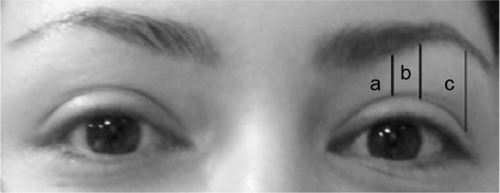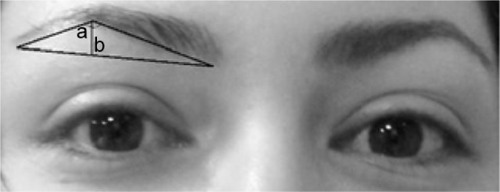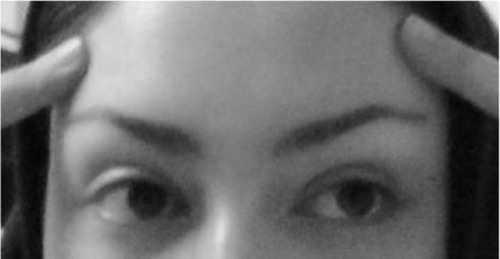Abstract
Purpose
The purpose of this study was to identify the different factors that an oculoplastic surgeon should consider while practicing cosmetic or reconstructive eyebrow surgery in order to have the final patient’s satisfaction.
Subjects and methods
In an observational case series study, five photographs were taken from each of 60 females to show ideal eyebrow positioning with fingers. Eyebrow landmarks, including tarsal plate show (TPS) and eyebrow height, were measured in the ideal position. Brow apex position and brow apex angle were evaluated in the desired position of eyebrow.
Results
The mean desired apex angle of eyebrow was measured as 135±9 mm. In all, 48.33% of our subjects preferred a wider brow angle, 28.33% a narrower one, and 23.33% a brow angle without any change. The location of brow peak was transferred to the lateral canthus in the desired position. The ideal brow peak in the lateral canthus and between lateral canthus and lateral limbus was assigned to 33.3% and 66.6% of cases, respectively. The desired eyebrow apex angle in two age groups of our subjects (>40 years and ≤40 years) was not statistically different.
Conclusion
Landmarks of the eyebrow and its desired position are somehow different between different studies, which may be explained by the variation in race, gender, culture, and age. As there is not any uniform rule in planning of cosmetic surgeries of eyebrow, oculoplastic surgeons should consider the difference in culture, race, age, and desire of the patients and have their surgical plans for every individual patient distinctively.
Eyebrow position importance
The eyebrow shape and position have a great role and influence on the cosmetic aspects of facial appearance. The appearance of the eyebrows is invested with an emotional, expressive, and psychological significance that makes them one of the most prominent features of the face. Studies have shown that one instantaneously and subconsciously makes a determination of another person’s mood just by glancing at the position and appearance of eyebrows.Citation1 In spite of several regulations that are created as ideal proportions of face and are used as a guide, the esthetic operations remain challenging.Citation1 Various parameters in the orbital region determine the facial appearance, including palpebral fissure height, eyelid crease, relation between eyebrow and orbital ridge, and location of brow apex. These parameters vary greatly between different races and culture. Age and gender can also affect and determine the ideal status of eyebrows. The features of face are the milestones of desired shape of eyebrow.Citation2–Citation5 In this study, we have evaluated the ideal amount of brow angle in 60 normal females, which can provide a guide for oculoplastic surgeons.
Subjects and methods
A total of 60 healthy females with the age ranging between 22 and 53 years without any previous history of plucked, removed, or tattooed eyebrows; facial surgery; facial trauma; and significant psychiatric problems who agreed to enroll in the research were studied. After complete explanation, oral informed consent was obtained. This study has been done under the observation of and approval by the ethics committee of Farabi Eye Hospital based on principles of the Declaration of Helsinki. Based on the committee policy for only observational studies, oral informed consent could be sufficient. The person in the images provided written consent for the images to be published. First, five photographs were taken by a Sony digital camera to show their ideal eyebrow positioning with fingers. The amount of tarsal plate show (TPS) was measured in three points, including medial canthus, mid pupil, and lateral canthus. The amount of brow fat span (BFS) in mid pupil, lateral limbus, and lateral canthus was calculated from the photographs (). The height of eyebrow was calculated by the height between top of eyebrow and the line passing horizontally from the inferior boundary of medial portion of the eyebrow (). The location and angle of eyebrow apex were considered. The brow apex angle was supposed as the angle between the medial portion of brow (usually the medial two-thirds) and brow tail (the lateral one-third). All of these variables were reported in millimeters (mm). All parameters have been measured by one examiner.
Figure 1 Measuring amount of BFS in mid pupil (a), lateral limbus (b), and lateral canthus (c).

In , the desired eyebrow position is depicted by one of the subject’s own finger in the mirror. The analysis of this investigation was done by SPSS version 19. The data were reported by mean ± SD. The percentage of the desired brow angle is reported.
Results
Our cases included 60 normal females with a mean age of 33.63±9.05 years. The amounts of TPS and BFS are shown in .
Table 1 The amount of TPS and BFS
The most common location of eyebrow peak was between lateral limbus and lateral canthus in 58.3% (35 cases) of subjects, followed by the lateral canthus (28.3% or 17 cases) and the lateral limbus (10% or six cases). There was no detectable eyebrow peak in two patients (3.3%).
The mean height of eyebrow was 7.51±1.85 mm, ranging from 4 to 13 mm. The mean desired apex angle of eyebrow was measured as 135±9 mm. In all, 48.33% of our subjects preferred a wider brow angle, 28.33% a narrower one, and 23.33% a brow angle without any change, but the location of brow peak was transferred to the lateral canthus in the desired position. Ideal brow peak in the lateral canthus and between lateral canthus and lateral limbus was assigned to 33.3% and 66.6% of cases, respectively. The desired eyebrow apex angle was estimated and compared between two age groups of our subjects, and the results are shown in . There was no statistically significant difference between these age groups (P<0.05).
Table 2 Desired eyebrow apex angle compared between two age groups
Cosmetic surgery was not performed for subjects after this study.
Discussion
Different variables affect the cosmetic aspects of eyebrows and consequently the cosmetic aspects of face, which comprise features of brow itself, location and amount of brow apex angle, quantity of BFS, relationship between brow and supraorbital ridge, and TPS. Eyebrow position and characteristics are important in sexual dimorphism and ethnic features of the face.Citation6
One of the parameters is the location of eyebrow apex that has been investigated in different studies. The various positions suggested were at the lateral canthus and over the lateral limbus by Cook et alCitation7 and Kunjur et al,Citation8 respectively. Another implication is that brow apex should be located at the intersection of middle and lateral thirds of upper eyelid.Citation9 In the study by Kunjur et al,Citation8 the apex of brow was positioned among the lateral limbus and lateral canthus in all cases with the exception of Indian men. In our study, the most frequent brow peak was located between lateral limbus and lateral canthus too. However in the remaining, the peak was situated at lateral limbus or lateral canthus. These differences may be explained by variation in race, gender, and age. In the investigation of Biller and Kim,Citation10 satisfying brow peak was located on the lateral limbus or middle of lateral limbus and lateral canthus. Sclafani and JungCitation11 showed that the desired brow peak was located on the lateral canthus, lateral limbus or middle of lateral canthus, and lateral limbus based on the age and race of subjects. Pham et alCitation12 described deep temporal fusion line as a new predictor of ideal brow peak in patients undergoing endoscopic brow lift procedures as the lateral limbus and medial two-thirds and lateral one-third junction may be a good indicator of brow peak in females, but it is not as equally useful as the deep temporal fusion line in the prediction of brow peak position in males and females. Our subjects preferred lateral canthus and places between lateral limbus and lateral canthus as the desired position for brow peak.
The location of brow under the supra orbital ridge in the medial partCitation9 and 1 cm on top of supra orbital ridgeCitation13 was suggested as a desired position in different studies.
The differences between two genders were considered in these variables in both anatomical status and ideal status.Citation12,Citation14,Citation15
We also measured the distance between the upper border of lid crease and lower edge of brow in three points, including mid pupil, lateral limbus, and lateral canthus. The results were between 3 and 18 mm, 4 and 19 mm, and 12 and 30 mm, respectively. Kunjur et alCitation8 established the amount of 7–12 mm; however, the amount of 15–16 mm was suggested for the ideal position.Citation16,Citation17
We measured the brow height in our subjects, and the result was 4–13 mm; nevertheless, a number of 13 was achieved in the other survey.Citation11
In other studies, the concept of ideal brow position and shape was greatly affected by age.Citation11,Citation18,Citation19 Feser et alCitation18 showed in their study that subjects younger than 30 years prefer eyebrows with lower positions and also ruled out arch, and it was exactly the opposite in groups of subjects older than 50 years. However in our study, there was no significant difference in the brow position preference between two age groups of our subjects younger and older than 40 years (). In the study by Kim et al,Citation20 there was not any significant difference in borrow archetype preference in different age groups, different educational levels, and single versus married women. As a limitation, we did not study our subjects’ desired eyebrow position based on their educational level and marital status.
The most significant result in our study that was never mentioned in other studies or it was considered without any changeCitation11,Citation19 was the wider brow apex angle preference. The brow apex angle (the angle between the medial portion of brow and brow tail) was significantly changed in the desired position of this study and became wider. In fact, the majority of our subjects believed in eyebrows with a wider apex angle as an ideal pattern, even more eminent than the shape and location of the apex of the eyebrow itself.
One of the major drawbacks of this study would be its population study, which comprises only female subjects. However, there is a fact that the majority of cases looking for cosmetic and reconstructive surgeries of eyebrows in our population study are females; thus, assessment of their desired eyebrow position would be favorable and useful information for planning of cosmetic and reconstructive surgery of eyebrows in our country. However, another drawback of this study would be its fairly small population of study.
The oculoplastic surgery for restoring ideal appearance is challenging and follows the special rules in facial proportions that are various in different races.Citation15,Citation20 By gathering miscellaneous information on this topic and consideration of the difference in culture, race, and desire of the patients, oculoplastic surgeons all around the world should have their surgical plans for every individual patient distinctively. In addition to these rules, the discernment of subject should be attended for obtaining arbitrary results.
Acknowledgments
This paper content was presented as a poster at the American Academy of Ophthalmology Annual Meeting, November 2013, New Orleans, USA. It has also been presented orally in “IV Annual Congress of Iranian Research Association for Vision and Ophthalmology (IRAVO), February 2014, Tehran, Iran” and “XXII Annual Congress of the Iranian Society of Ophthalmology, October 2013, Tehran, Iran.Citation21 This manuscript has not been published or submitted for publication elsewhere.
Disclosure
The authors report no conflicts of interest in this work.
References
- Naif-de-AndradeNTHochmanBNaif-de-AndradeCZFerreiraLMComputerized photogrammetry used to calculate the brow position indexAesthetic Plast Surg20123651047105122936380
- YalçınkayaECingiCSökenHUlusoySMulukNBAesthetic analysis of the ideal eyebrow shape and positionEur Arch Otorhinolaryngol2016273230531025348339
- LiewSEthnic and gender considerations in the use of facial injectables: Asian patientsPlast Reconstr Surg20151365 suppl22S27S26441103
- PapageorgiouKIAngMChangSHKohnJMartinezSGoldbergRAAesthetic considerations in upper eyelid retraction surgeryOphthal Plast Reconstr Surg2012286419423
- ZoumalanCIRoostaeianJSimplifying blepharoplastyPlast Reconstr Surg20161371196e213e
- PackiriswamyVKumarPBashourMPhotogrammetric analysis of eyebrow and upper eyelid dimensions in South Indians and Malaysian South IndiansAesthet Surg J201333797598224018869
- CookTABrownriggPWangTDQuatelaVCThe versatile mid-forehead browliftArch Otolaryngol Head Neck Surg198911521631682914087
- KunjurJSabesanTIlankovanVAnthropometric analysis of eyebrows and eyelids: an inter-racial studyBr J Oral Maxillofac Surg2005442899315936856
- WhitakerLAMoralesLFarkasLGAesthetic surgery of the supraorbital ridge and forehead structuresPlast Reconstr Surg198678123323523556
- BillerJAKimDWA contemporary assessment of facial aesthetic preferencesArch Facial Plast Surg2009112919719289680
- SclafaniAPJungMDesired position, shape, and dynamic range of the normal adult eyebrowArch Facial Plast Surg201012212312720231595
- PhamSWilhelmiBMowlaviAEyebrow peak position redefinedAesthet Surg J201030329730020601552
- EllenbogenRTranscoronal eyebrow lift with concomitant upper blepharoplastyPlast Reconstr Surg19837144904996828583
- CartwrightMJKurumetyURNelsonCCFruehBRMuschDCMeasurements of upper eyelid and eyebrow dimensions in healthy white individualsAm J Ophthalmol199411722312348116752
- PriceKMGuptaPKWoodwardJAStinnettSSMurchisonAPEyebrow and eyelid dimensions: an anthropometric analysis of African Americans and CaucasiansPlast Reconstr Surg2009124261562319644282
- ConnellBFLambrosVSNeurohrGHThe forehead lift: technique to avoid complications and produce optimal resultsAesthetic Plast Surg19891342172372596366
- McKinneyPMossieRDZukowskiMLCriteria for the forehead liftAesthetic Plast Surg19911521411472035363
- FeserDKGrundlMEisemann-KleinMPrantlLAttractiveness of eyebrow position and shape in females depends on the age of the beholderAesthetic Plast Surg200731215416017235461
- MataiOLavezzoMMSchelliniSAPadovani CarlosRPPadovaniREvaluation of eyebrow position using angular measuresArq Bras Oftalmol2007701414417505717
- KimSKChaSHHwangKHwangSWKimYSBrow archetype preferred by Korean womenJ Craniofac Surg20142541207121125006898
- RajabiMtMakatebAFree papers session in orbit and cosmetic surgeryPresented at: 22nd Iranian Society of Ophthalmology congressOctober; 2013Tehran, Iran


